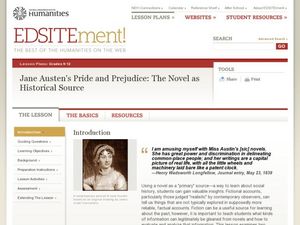Curated OER
A Dream of Classic Perfection
Learners look at how Greek classical art and philosophy influenced the French Revolution. In this French Revolution lesson, students use primary sources, Neoclassical art, to look at how they show what society was like during this time...
Museum of the American Revolution
The Ongoing Revolution
America: a nation that continues to change. Budding historians analyze primary sources to understand the key ideas of the American Revolution and how the country has changed over time. Scholars read text from the Declaration of...
Jamestown-Yorktown Foundation
How Did Relations between Britain and the Colonies Change after the French and Indian War?
What does the French and Indian War have to do with the American Revolution? Following the war, Britain issued the Proclamation of 1763 in an attempt to limit the colonists' western expansion. To understand how the proclamation, the...
North Carolina Consortium for Middle East Studies
The French and Indian War: The War That Shaped America’s Destiny
How would a Frenchman, Englishman, and Native American have each viewed the French and Indian War? Your young historians will learn about their unique perspectives and the war as a whole through a role-playing activity,...
Curated OER
Major Events Leading to the American Revolution
Learners explore the causes of the American Revolution. In this taxation without representation instructional activity, students analyze political cartoons in order to gain an understanding of the efforts of the colonists to resolve...
Curated OER
Turning Points in the American Revolution
Fifth graders examine the causes and effects of the American Revolution. In groups, they make a portfolio page and write a response to the Proclamation of 1763. They also make a timeline of the events of the Boston Massacre and answer...
National Endowment for the Humanities
The War in the South, 1778–1781
The second in a three-part look at the Revolutionary War focuses the years from 1778 through 1781 and zooms in on military operations in the southern colonies, the French alliance, and the role African-Americans played in events. Class...
Curated OER
Marie Antoinette: The Tragic Queen
Learners view a documentary on Marie Antoinette, who became a symbol of the reviled monarchy. After viewing, students discuss what they saw then create a family line of Marie Antoinette. They compare maps of Europe from her time to ours.
Roy Rosenzweig Center for History and New Media
The Boston Massacre: You Be the Judge!
The importance of considering multiple perspectives of the same event is the big idea in this exercise that focuses on the Boston Massacre. Class groups examine photos of four depictions of the massacre, an English and an American...
Los Angeles Unified School District
Why Is the Declaration of Independence Important?
Fair or unfair? To begin a study of the American Revolution, class members review the treatment of the people of the American Colonies by the King of England and decide which were fair and which were unfair. Class members then annotate a...
Curated OER
George Washington - A Graphic Novel
Young scholars write and illustrate their own graphic novels. In this George Washington instructional activity, students collaborate to research Washington's life as surveyor, his involvement in the French and Indian War as well as the...
Benjamin Franklin Tercentenary
Join, or Die: Reenacting the Albany Conference
The Albany Congress was one of the first attempts at colonial unity. While it was an effort against the French during the French and Indian War, it was one of the events leading up to the American Revolution. Scholars consider the...
Curated OER
Yorktown
Students examine the last major battle of the Revolutionary War at Yorktown. After viewing photographs, they participate in simulations of the surrender by Cornwallis. To end the lesson, they put the events of the battle into the...
Curated OER
The War in the South, 1778-1781
Students explore the major terms of the Franco-American alliance and their importance to the cause of independence. The most important military engagements in the South are discussed and their significance for the outcome of the war noted.
Curated OER
Jane Austen's Pride and Prejudice: The Novel as Historical Source
Students examine historical fiction as historical sources. In this historical fiction lesson, students analyze excerpts from Jane Austen's Pride and Prejudice as well as Mary Wollstonecraft's A Vindication of the...
Roy Rosenzweig Center for History and New Media
Patriots or Traitors - Point of View in the War for Independence
Patriots or traitors? Class members analyze images that present widely differing views of the Boston Tea Party, identifying the point of view of the image, the propaganda devices used, and the intended audience.
Curated OER
Can't You Make Them Behave, King George?
Fifth graders describe the changes in King George III's policy toward the American colonies by sequencing key events between the French and Indian War and the American Revolution. They explain the colonial reactions to command decisions...
Benjamin Franklin Tercentenary
Benjamin Franklin and the Long Struggle for Independence
Students explore U.S. history by reading biographical material in class. In this Benjamin Franklin lesson, students identify the life of Franklin and the events that led him to become one of America's first heroes. Students complete an...
Curated OER
Boston Spies' Report on the Redcoats
Students collect information about British actions in Boston and send it by secret message to leaders in Philadelphia.
Curated OER
Lesson 4. Killing Fields
Eleventh graders describe several of the WWI's bloodiest battles, track the battles' progression to determine advances made by leading nations, and write frontline journalistic accounts of one or more of the battles.




















